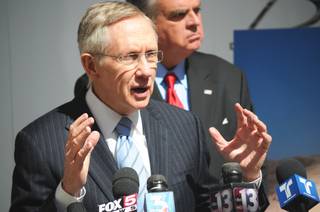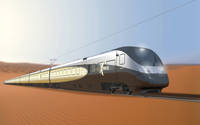Sun archives
- Is America ready to manage high-speed rail? (4-27-2011)
- DesertXpress high-speed rail project rolls forward (3-25-2011)
- DesertXpress rail project going after tax dollars, after all (2-21-2011)
- DesertXpress top executive retires from high-speed rail project (12-17-2010)
- With new leaders, a revival of maglev high-speed rail? (11-25-2010)
- Harry Reid hopeful DesertXpress gets support from next governor (10-13-2010)
- Transportation secretary envisions nation connected by high-speed rail (10-13-2010)
- High-speed rail: Will it be worth the wait for Nevadans? (9-31-2010)
- DesertXpress likely further delayed by a federal agency (9-24-2010)
- Work on high-speed rail set to begin this year (3-25-2010)
- $45 million for maglev shifted to airport road project (3-17-2010)
- Backers of maglev train say Chinese bank prepared to fund project (2-3-2010)
- Maglev train backers woo contractors with promise of jobs (1-22-2010)
- DesertXpress prepared to build; maglev, monorail extension on hold (1-15-2010)
A transportation expert and a UNLV professor want to leverage Las Vegas’ potential as a high-speed rail transportation hub to develop a university program dedicated to the research and study of high-speed rail.
Tom Skancke, a public affairs consultant and president and CEO of the Skancke Company, and Harry Teng, an associate professor at UNLV’s Howard Hughes College of Engineering, plan to take their proposal — which they have been refining for almost two years — to university administrators early next year. They hope to affiliate what they tentatively are calling the International High Speed Rail Institute with UNLV’s engineering school.
Skancke and Teng say the cost of establishing the institute would depend on how elaborate it is, but Skancke said he expects it would cost between $650,000 and $900,000 initially.
They plan to approach industry leaders to form an advisory board to guide them on raising the money.
Las Vegas could become the West’s high-speed rail center if a proposed XpressWest project comes to fruition. Developers want to link Las Vegas and Los Angeles with a high-speed train that would travel through Victorville and Palmdale, Calif.
“I still think we’re going to be the first in the country to have high-speed rail,” Skancke said in a recent interview with VEGAS INC, the Sun’s sister publication. “If we’re going to have high-speed rail in this country, I think the research, the education, the student exchange programs and the faculty exchange programs should be done here in the West because we’re the pioneers on this.”
Skancke, who is a consultant to the Las Vegas Convention and Visitors Authority on transportation issues, also is executive director of the Western High Speed Rail Alliance, an organization composed of transportation groups from Nevada, Utah, Arizona and Colorado. The alliance hopes eventually to build a high-speed rail network that connects Las Vegas, Salt Lake City, Phoenix and Denver, an effort it acknowledges would take decades and billions of dollars to complete.
Skancke views the planned XpressWest line between Las Vegas and Southern California as a crucial first step.
But high-speed rail is new to this country. Where would the engineers, managers and operators of a rail system come from? Where would they learn how to build and maintain a train?
That’s where the proposed institute comes in.
Skancke first met Teng in 2010, after the Western High Speed Rail Alliance held its first conference in Las Vegas.
“I got this call from Harry wanting to meet and I said, ‘Why does a professor at UNLV want to meet with me?’ And he’s an engineering professor,” Skancke recalled. “So I met with him and some of his colleagues, and they had put together this concept of creating a kind of high-speed rail college within the engineering school at the university.”
The two continued to meet to refine the concept and decided to propose a regional institute.
“I’m all about getting high-speed rail in the West, and I thought, ‘Why should something like this be at the University of Delaware or the University of Illinois when we have all this talent right here?’” Skancke said.
Skancke and Teng developed a friendship that led them to travel halfway around the world to observe operating high-speed train systems and visit universities that produce graduates capable of building and maintaining them.
Teng is highly regarded in China, particularly at Beijing’s Jiaotong University, which has institutes dedicated to transportation, electric power, civil engineering and architecture. The university has been involved in high-speed rail education for 20 years.
Teng and Skancke traveled to China last year and met with the leaders of Jiaotong’s programs about the possibility of collaborating with UNLV.
One of Jiaotong’s professors sent a letter in support of establishing an American-based institute to UNLV President Neal Smatrask, and one of the university’s administrators signed a memorandum in early 2011 pledging cooperation with UNLV.
When Skancke and Teng returned from China, they began talking with industry leaders about the value of an institute to their companies. Teng went to work outlining potential degree programs.
Teng envisions the institute offering bachelor’s, master’s and doctoral degree programs in various subject areas involving high-speed rail. He also pictures a certificate program for students who aren’t seeking advanced degrees. Programs would be developed for construction workers and managers, train operation crews, station managers and operators, and maintenance professionals and technicians.
Skancke also proposed collaborations with other western universities that have established engineering, transportation and hospitality programs. They could contribute teachers and lecturers through distance-learning courses.
Skancke named UNR, the University of Arizona and Arizona State University, the University of Utah and Utah State University, the University of Colorado and Colorado State University, and Brigham Young University as prospective partners. He also identified China’s Southwest Jiaotong University, Taiwan’s National Cheng Tung University, Japan’s University of Tokyo, China’s Dalian University of Technology and Germany’s Technische Universitat Braunschweig as prospective international partners.
One of the institute’s long-term goals would be to build a test track in Southern Nevada.
“We have a lot of topographical extremes in the United States that they don’t have in Europe and Asia,” Skancke said. “It could be 80 degrees in Las Vegas and snowing in San Bernardino County. And we still don’t really know how the desert extremes and the dust in those desert environments will affect high-speed rail operations.”
Train operations in extreme heat and the effects of seismic activity would likely be important research areas at the institute. Researchers also could investigate the use of solar energy to power rail systems.
Teng already is writing or has finished nine outlines for courses in railroading and high-speed rail technology that would be available at UNLV. Twenty-six professors there teach civil, mechanical or electrical engineering classes that could be folded into the institute’s mission.
Students also would be able to take specialized classes at the university’s Transportation Research Center and from other UNLV departments, including business, liberal arts, urban affairs and hotel administration.
UNLV already has in place one of 10 student chapters of the American Railway Engineering and Maintenance-of-Way Association, and student members correspond with other chapters nationwide about rail engineering.
Skancke believes an international institute would raise the credibility and visibility of UNLV, especially if it is the center of a regional program.
“This brings the higher education region together under one umbrella,” Skancke said.
Skancke and Teng imagine that graduates from the institute would be equipped to go out into the world and design and build high-speed rail systems in other desert regions.
Not only would the concept fit in with Gov. Brian Sandoval’s economic diversification efforts to create new jobs and employment sectors locally, it also could be a catalyst to build business relationships with China, Japan and Europe’s high-speed rail leaders in Germany, France, Spain and Italy, Skancke said.
“The international partnerships are endless,” he said.
Past studies have indicated that the XpressWest project could generate up to 45,000 jobs over a three-year period with a payroll exceeding $3.4 billion.
Still, as great as they think the idea may be, Skancke is mindful that there are costs associated with developing the concept.
So he is forming a regional advisory board to try to find funding for the project. Over the next few months, he’ll approach industry experts to form the group that would be charged with raising money. Skancke figures rail companies will want to help as they will need a trained workforce.
“We’re thinking big on this,” Skancke said. “How do we get Las Vegas outside of the boundaries of the state of Nevada and make this a global city? I think this is the first step.”


